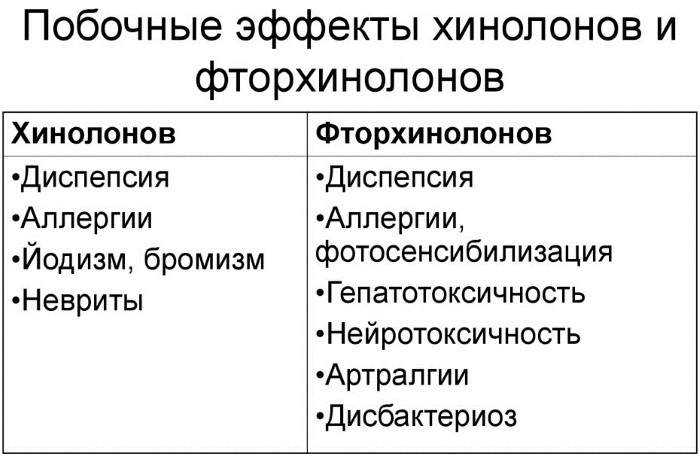Pyoderma is a purulent-infectious lesionthat penetrates deep under the skin. Antibiotics for treatment are prescribed for any type of pathology. It can be primary or secondary. It is treated depending on the cause of the lesion and the stage of the disease.
Record content:
- 1 Classification
-
2 Top 10 drugs from the pharmacy
- 2.1 "Amoxicillin"
- 2.2 "Levomekol"
- 2.3 "Hydrocortisone"
- 2.4 "Gyoksizon"
- 2.5 "Salicylic ointment"
- 2.6 "Triderm"
- 2.7 "Actovegin"
- 2.8 "Fukortsin"
- 2.9 "Erythromycin"
- 2.10 Lincomycin
- 3 Video about the treatment of pyoderma
Classification
Antimicrobial drugs are more suitable for the treatment of pyoderma. They are selected depending on the cause of the lesion, its degree, area of distribution. More often, antibiotics are used that act on several types of pathogenic agents at once. These drugs are prescribed for any form of pyoderma. They can be in the form of tablets, injections, external agents.
Pyoderma (antibiotics for treatment remain a priority) additionally requires the treatment of integuments with alcohol solutions, ointments, antiseptics. Antibacterial agents are often prescribed for multiple lesions. For secondary infection, combined topical glucocorticosteroid drugs are used.
If the patient has antibiotic intolerance, sulfa drugs are prescribed. They are no less effective than antibacterial ones.
If the lesions are deep under the skin, enzymes and ointments are prescribed to accelerate regenerative processes. They help prevent the spread of pus through the tissues and ensure deep penetration of medicinal components. For ulcers, dressings are applied with medicine.
| Group | General description, name of drugs |
| Anti-inflammatory | Reduce inflammation, pain, suppress pathogenic bacteria:
|
| Antibacterial | Antibiotics are prescribed if treatment with ointments is ineffective, in the chronic course of pyoderma, accession of a secondary infection, to prevent its spread, with an increase in negative symptoms. An antibacterial drug is selected after an antibioticogram, with the help of which the sensitivity of pathogens to the drug is determined. With pyoderma, the following can be prescribed:
Antibiotic treatment is carried out in courses of 5 days or more. |
| Immunostimulants | Use drugs that stimulate the immune system. They are necessary when relapses of pyoderma are repeated at least once a month. This group of medicines includes: 1. Purified staphylococcal adsorbed toxoid. 2. The vaccine is staphylococcal, streptococcal. 3. Antistaphylococcal human immunoglobulin. 4. Staphylococcal or streptococcal bacteriophages. 5. "Leukinferon" with interferon (enhances the immune response to the invasion of pathogenic microorganisms). The listed drugs increase immunity and stimulate the production of antibodies to fight the corresponding infection (in particular, staphylococcal, which most often provokes pyoderma). |
| Glucocorticosteroids | These are hormonal drugs, therefore they are used only for extensive lesions, severe forms of pyoderma development (for example, "Metipred", "Hydrocortisone"). |
In addition to antibiotics for treatment, pyoderma therapy is supplemented with angioprotectors (Trental, Actovegin). These are complex preparations that are used to strengthen blood vessels, capillaries. They increase their elasticity, accelerate tissue regeneration.
Top 10 drugs from the pharmacy
Pyoderma (antibiotics for treatment are necessary to stop the infection) is always accompanied by skin lesions. Therefore, they need to be treated with brilliant green, a solution of potassium permanganate or "Chlorhexedin". They inhibit the growth of pathogenic bacteria and have an antiseptic effect.
With pyoderma, treatment can be complex, acting in several directions - elimination symptoms and inflammation, preventing the spread of pus through healthy tissues, proliferation of foci defeat. Therefore, several drugs can be prescribed for therapy at once.
"Amoxicillin"
Pyoderma (antibiotics for treatment are the mainstay of therapy) can be caused by various pathogenic agents. Therefore, they choose drugs with a wide spectrum of action, more often - "Amoxicillin". Release form - granules for suspension preparation, oval convex tablets from 125 to 1000 mg or capsules in a gelatinous shell of 250.500 mg each.
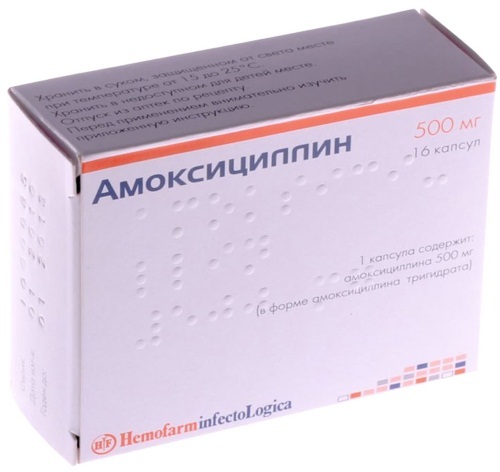
The active ingredient is amoxicillin, presented in the form of trihydrate. The drug is a broad spectrum of action. It is prescribed for bacterial infections, infectious inflammation of soft tissues, for the treatment of diseases of the respiratory and genitourinary systems.
It is a semi-synthetic antibiotic of the penicillin group. Actively acts against a large number of pathogenic microorganisms. Violates the structure of the cell walls of bacteria, which leads to their destruction.
Instructions for use:
- children 2-5 years old - 125 mg, 3 times a day;
- at the age of 5-10 years - 250 mg for three doses per day;
- from 10 years old - 250-500, 3 times a day.
The treatment regimen is adjusted by the doctor on an individual basis, for adults it is possible to increase the dosage up to 1000 mg. If a suspension is used for oral administration, then an interval of 8 hours must be observed between them. Amoxicillin can be taken before or after meals.
Indications:
- bacterial lesions of the respiratory, genitourinary and excretory systems;
- any types of pyoderma;
- eradication;
- sinusitis, otitis media, staphylococcal pharyngitis and tonsillitis;
- inflammation of soft tissues, endometrium, intestines;
- typhoid fever;
- infection of the prosthetic joints;
- Lyme disease
- defeat by the bacteria Helicobacter Pylori;
- an abscess located near the teeth;
- listeriosis;
- gonococcal infection;
- extensive skin lesions.
Contraindications:
- allergy to an active substance;
- diseases of the respiratory system of a viral nature;
- allergic diathesis;
- excessive sensitivity to cephalosporins and penicillins;
- infectious diseases of the gastrointestinal tract in severe form with stool disorders;
- hay fever;
- pregnancy;
- asthma;
- liver disease.
"Amoxicillin" should not be taken simultaneously with metronidazole in case of sensitivity to derivatives of nitromidazole, lymphocytic leukemia, diseases of the central nervous system.
Possible side effects - allergic reactions (redness, swelling, including Quincke), disruption of the gastrointestinal tract, stool. From the side of the nervous system - overexcitement, convulsions, dizziness. Sometimes the heart rhythm, breathing is disturbed, the level of erythrocytes, neutrophils, leukocytes decreases.
In case of an overdose, nausea, stool disturbance occurs, but the likelihood of severe complications is low. Available from pharmacies by prescription. Price - 80-400 rubles.
"Levomekol"
Pyoderma (antibiotics for treatment are available in different forms) goes well after applying the Levomekol ointment. The active ingredients are dioxomethyltetrahydropyrimidine and chloramphenicol. The ointment contains an antibiotic, promotes wound healing, relieves inflammation. Penetrates deep into tissues, promotes rapid regeneration, draws out pus.
"Levomekol" can be used from 3 years of age. The ointment is applied to the wound and fixed with a bandage. Until the wound is cleared of pus, dressings are done daily, then every other day. Use the ointment for at least 4 days in a row.

Indications:
- healing of skin lesions, bedsores, boils;
- purulent acne;
- herpes;
- haemorrhoids;
- corns and calluses;
- ulcerative skin lesions;
- acute and chronic lymphadenitis;
- trophic ulcers;
- periodontal disease;
- balanoposthitis.
Contraindications - eczema, fungal skin lesions, psoriasis. The drug can not be used in case of intolerance to the components of the composition. Possible side effects are allergic manifestations (itching, burning, tissue swelling), urticaria, hyperemia, dermatitis. Overdose cases were not recorded. Available from pharmacies without a prescription. Price - 140-160 rubles.
"Hydrocortisone"
Release form - powder for suspension preparation, ready-made solution in ampoules, ointment. The active ingredient is hydrocortisone acetate. It is often prescribed as an external agent for skin lesions.
Reduces capillary permeability, exudative reaction, the severity of the early response of the immune system. Prevents scarring and connective tissue formation. It is an anti-inflammatory and anti-allergic hormonal drug. It is used only for severe forms of diseases, in a short course.
With pyoderma, ointment is mainly used. It is applied to the affected area 2-3 times a day, in a thin layer. The course of treatment is 1-2 weeks. If necessary, the treatment can be extended up to 20 days.
If hypertrophic manifestations are observed, occlusive dressings are applied to the affected areas, which must be changed every 1-2 days. Apply the ointment to the face carefully, avoiding contact with the mucous membranes. For children, bandages are applied once, the duration of treatment is reduced.
Indications:
- inflammatory diseases of the joints;
- eczema, dermatoses;
- some eye diseases;
- hay fever;
- nephrotic syndrome;
- dermatitis;
- collapse with Addison's pathology;
- psoriasis;
- infectious and inflammatory diseases (pyoderma, furunculosis);
- failure of the liver, adrenal glands;
- thyrotoxic crisis;
- lupus erythematosus;
- erythroderma;
- Crohn's disease;
- neurodermatitis;
- ulcerative colitis.
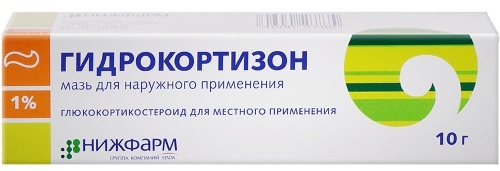 Contraindications:
Contraindications:
- fungal and purulent eye diseases;
- previously untreated parasitic infections;
- primary glaucoma;
- osteoporosis;
- diabetes;
- child's age up to one year;
- renal failure;
- epilepsy;
- nephritis;
- severe hypertension;
- peptic ulcer;
- Itsenko-Cushing's pathology;
- systemic mycoses;
- active tuberculosis;
- peptic ulcer;
- intolerance to the components of the drug;
- perioral dermatitis;
- the ointment should not be applied to wounds, cuts on the skin;
- syphilis.
Possible side effects after applying the ointment are the appearance of irritation at the site of application (burning, redness, itching), rash, hyperemia, swelling may occur. Other side effects are rare. Overdose with topical application of the ointment is excluded, only a slight burning sensation is possible. Available from pharmacies without a prescription. Price - 30-260 rubles.
"Gyoksizon"
Release form - in the form of an ointment. The active ingredients are hydrocortisone and oxytetracycline. The drug has anti-inflammatory and antibacterial effects.
The ointment is applied to the damaged area with a thin layer 3 times a day. Fix with a gauze bandage or bandage. The course of treatment is 7-14 days.
Indications:
- all types of pyoderma;
- seborrhea;
- burns;
- infected wounds;
- insect bites;
- erysipelas;
- purulent wounds;
- dermatitis.
Contraindications:
- pregnancy;
- viral skin pathologies;
- mycosis;
- lupus;
- tumors;
- intolerance to the components of the drug.
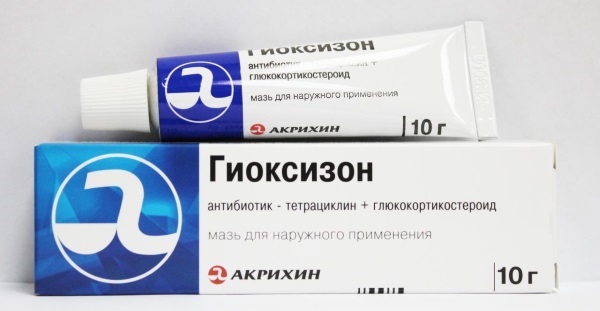 Possible side effects are itching, rash, burning. Sometimes allergic reactions appear, atrophy of the subcutaneous tissue is formed. Overdose was not recorded. Available from pharmacies without a prescription. Price - 60-80 rubles.
Possible side effects are itching, rash, burning. Sometimes allergic reactions appear, atrophy of the subcutaneous tissue is formed. Overdose was not recorded. Available from pharmacies without a prescription. Price - 60-80 rubles.
"Salicylic ointment"
The release form is in the form of an ointment in aluminum tubes. The active ingredient is salicylic acid. It is anti-inflammatory, antiseptic. The ointment accelerates the healing of soft tissues, wounds, boils. Softens outgrowths and calluses, fights acne. Improves exfoliation of dead cells, accelerates regeneration.
First, the affected area is treated with "Chlorhexedin". Then the ointment is applied and spread in a thin, even layer. The procedure is repeated 1-2 times a day. Or the ointment is applied to the skin in a dense layer, and a special bandage is applied on top. Change it after 2-3 days. The course of treatment is up to 7 days.
Indications:
- dyskeratosis;
- ichthyosis;
- pyoderma;
- acne lesion;
- warts;
- oily seborrhea;
- psoriasis;
- chronic form of eczema.
Contraindications - infancy, intolerance to the components of the drug, allergy to the composition of the ointment. From side effects, itching, burning, skin rashes can be observed for a short time. Overdose was not recorded. Available from pharmacies without a prescription. Price - 30-50 rubles.
"Triderm"
Release form - in the form of an ointment, cream. The active ingredients are clotrimazole, gentamicin, betamethasone. The drug has antifungal, antibacterial effect.

The ointment is applied to the damaged areas of the skin 2 times a day. The course of treatment is until the complete relief of the disease. This can take up to a month. Indications - infectious skin lesions, dermatitis, lichen simplex, eczema.
Contraindications:
- children's age up to two years;
- lupus;
- herpes simplex;
- chicken pox;
- cutaneous manifestations of syphilis.
Possible side effects are burning, itching, redness. Sometimes a rash, erythema, and peeling of the skin appear. With prolonged use of the ointment, the work of the adrenal glands may be disrupted, their insufficiency, hypercortisolism may occur. Available from pharmacies without a prescription. Price - 680-850 rubles.
"Actovegin"
Release form - in tablets, solutions for intravenous administration. It is also made as an external agent - ointment, gel, cream. The active ingredient is a deproteinized hemoderivat from the blood of young calves.
The drug activates metabolism in tissues, improves trophism, accelerates the regeneration process. The resistance of tissues to hypoxia increases, the energy resource of cells increases. The drug helps to restore normal blood circulation in damaged areas, accelerates wound healing, restores skin sensitivity.
Instructions for use:
- In the form of injections, it is used to restore the blood supply to tissues - intravenously, intramuscularly once a day. First - 10 ml for 14 days, then 5-10 ml 2-3 times a week. This pattern can vary depending on the disease.
- For sluggish ulcers and burns, 10 ml is injected first into a vein, then another 5 ml is injected intramuscularly. Usually once a day, but can be prescribed twice a day.
- Gel and ointment are used when long-term treatment of pyoderma and other skin lesions is required. First, the gel is applied in a thin layer, then - the ointment on a gauze bandage. It is fixed and changed once a day, but if the wound gets very wet - twice a day. For bedsores, a new dressing is done every 3-4 hours.
- The cream is applied to the affected areas 2-3 times a day. You can also use an ointment (no gel). With severe skin lesions, it is allowed to apply it up to 4 times a day. The course of treatment is at least a week.
 Indications for "Actovegin" in tablets are metabolic and vascular disorders of the brain, angiopathy, trophic disorders and diabetic polyneuropathy.
Indications for "Actovegin" in tablets are metabolic and vascular disorders of the brain, angiopathy, trophic disorders and diabetic polyneuropathy.
Indications:
- for the prevention and treatment of pressure ulcers;
- with inflammatory processes on the mucous membranes and skin;
- burns, cracks, abrasions;
- pyoderma;
- weeping ulcers;
- prevention of skin manifestations after radiation.
The indications for the gel are similar, but in addition, in this form, the drug is used to treat the skin before transplantation - during the treatment of burns.
Contraindications:
- sensitivity to drug components;
- pulmonary edema;
- anuria;
- heart failure in a decompensated form;
- oliguria;
- fluid retention in tissues.
Possible side effects are allergic manifestations (urticaria, edema, severe sweating), disruption of the gastrointestinal tract, nervous and cardiovascular systems. Sometimes the drug causes pain in the lower back, bones, joints. Difficulty swallowing and choking, respiratory failure, sore throat may appear. There were no cases of ointment overdose.
Available from pharmacies without a prescription. The price of the ointment is 100-150 rubles.
"Fukortsin"
Release form - in solution. The active ingredient is boric acid. This is a combined preparation for external use. Has fungicidal and antimicrobial effects. Prevents the spread of infection, dries up wet wounds, ulcers.
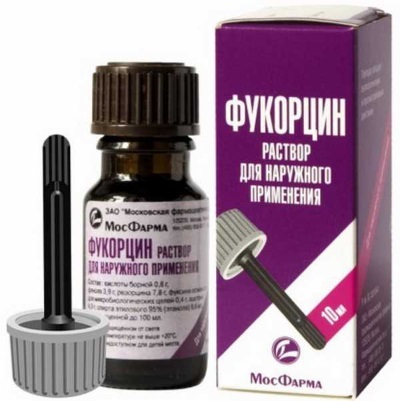
The solution is used to treat skin lesions several times a day. After it dries, a cream or ointment is applied.
Indications:
- pustular lesions;
- cracks and abrasions;
- wounds;
- fungal pathologies;
- erosion.
Contraindications - intolerance to the components of the drug. Application of the solution in large quantities can provoke dizziness, respiratory failure, and disturb the stability of pressure. Possible side effects are only a slight burning sensation.
Available from pharmacies without a prescription. Price - 20-80 rubles.
"Erythromycin"
Release form - tablets, ointments. The active ingredient is erythromycin. A drug from the macrolide group. It has a bacteriostatic and bactericidal effect, not only stopping pathogenic agents, but also destroying them. It relieves inflammation, is active against gram-positive bacteria and some gram-negative microorganisms.
Instructions for use: for pyoderma, the ointment is applied to the affected area three times a day or applied once a day under a sterile bandage. With a small lesion, a mild form of the disease, a course of treatment of several days is sufficient. If the disease is severe, progresses, therapy can be extended up to a month.
Indications:
- severe infections with heavy discharge of pus;
- respiratory tract diseases;
- brucellosis;
- syphilis;
- gonorrhea;
- acne;
- bedsores;
- infectious skin lesions;
- burns;
- trophic ulcers.
Contraindications - individual intolerance to the components of the drug, hepatitis, serious kidney disease and liver failure. When using the ointment, some prohibitions may be relative. A doctor's consultation is required.
Possible side effects - abnormalities in the liver of the gastrointestinal tract, allergic reactions. In some patients, hearing deteriorates, heart rhythm failure occurs. The drug seeps through the placenta, therefore it is contraindicated during pregnancy and lactation.
Overdose of the ointment was not recorded, after oral administration, nausea, stool disturbance, manifestation of allergic reactions are possible, but such cases are rare. With prolonged use of the ointment, secondary infection can occur.
Available from pharmacies without a prescription. Price - from 30 rubles.
Lincomycin
Release form - in capsules, solution. The active ingredient is lincomycin. The drug is a broad spectrum of action, contains an antibiotic, quickly copes with the infection. Belongs to the group of lincosamides.
The dosage of the drug is not more than 1.8 g per day, but in severe cases it can be increased to 2.4 g. Injections are given 3 times a day with an interval of 8 hours. For children, the dosage is calculated as 10-20 mg / 1 kg. Capsules are given three times a day, one hour before meals or two afterwards, 500 mg each. Duration of treatment is 1-2 weeks.
Indications:
- diseases of the joints, bones;
- infectious diseases of the respiratory system;
- skin pathologies;
- purulent wounds;
- abscesses;
- inflammation of soft tissues.
Contraindications - intolerance to the components of the drug, severe liver and kidney disease, age up to 6 years. Possible side effects - muscle weakness, headaches, allergic manifestations. Sometimes there is dizziness, disorders of the gastrointestinal tract and hematopoiesis. No cases of overdose have been identified.
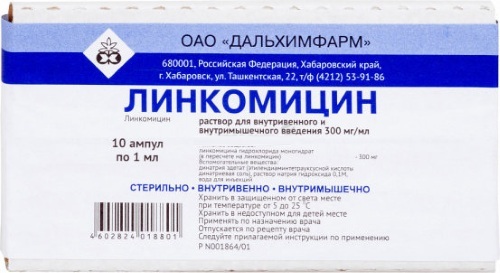
Available from pharmacies by prescription. Price - 70-150 rubles.
With pyoderma, antibiotics are always prescribed for treatment. It is aimed at eliminating the factors that provoked the disease and relieving symptoms. The course of treatment is selected individually. Since it is based on antibacterial agents, they can change with prolonged therapy in order to avoid the addiction of pathogens to a particular drug.
Video about the treatment of pyoderma
Pyoderma treatment:


